Science
Reusing Recyclables: 10 Science Tools to Make for StudentsMay 22, 2024

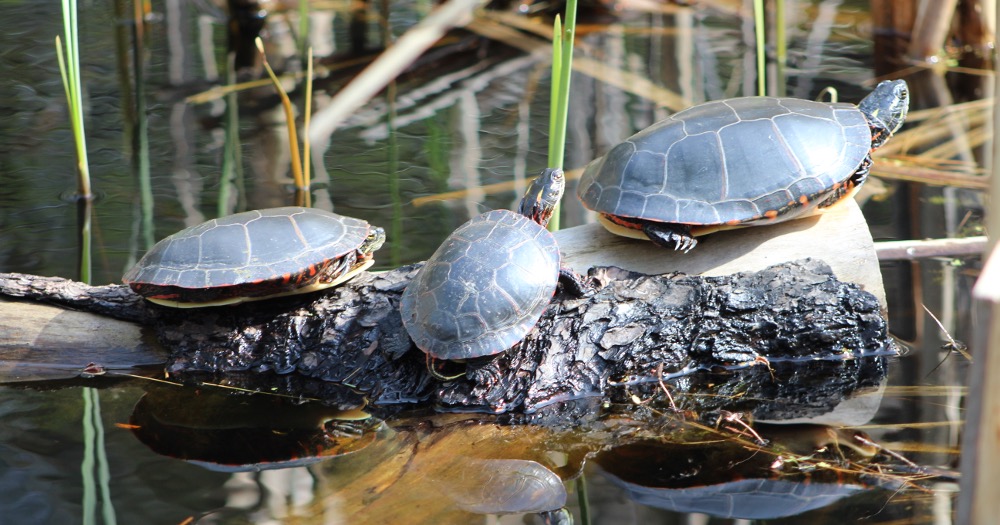
Amphibians vs reptiles may be one of the hottest topics you cover this school year. Not only are these animals inherently interesting to children (and many adults!), they are also confusing to keep separate. Are reptiles and amphibians the same? What are the characteristics of amphibians? What is the difference between amphibians and reptiles? These questions and more will be addressed in this article as we celebrate these amazing creatures for their unique characteristics.
Don’t need all the info? Use this list to jump to the stuff you need:
Difference between amphibians and reptiles
How to teach amphibians vs reptiles
When people think about amphibians vs reptiles, one question often pops up: are reptiles and amphibians the same? Although these groups of animals look similar, there are some special characteristics that make them unique from each other as well as other animal groups.
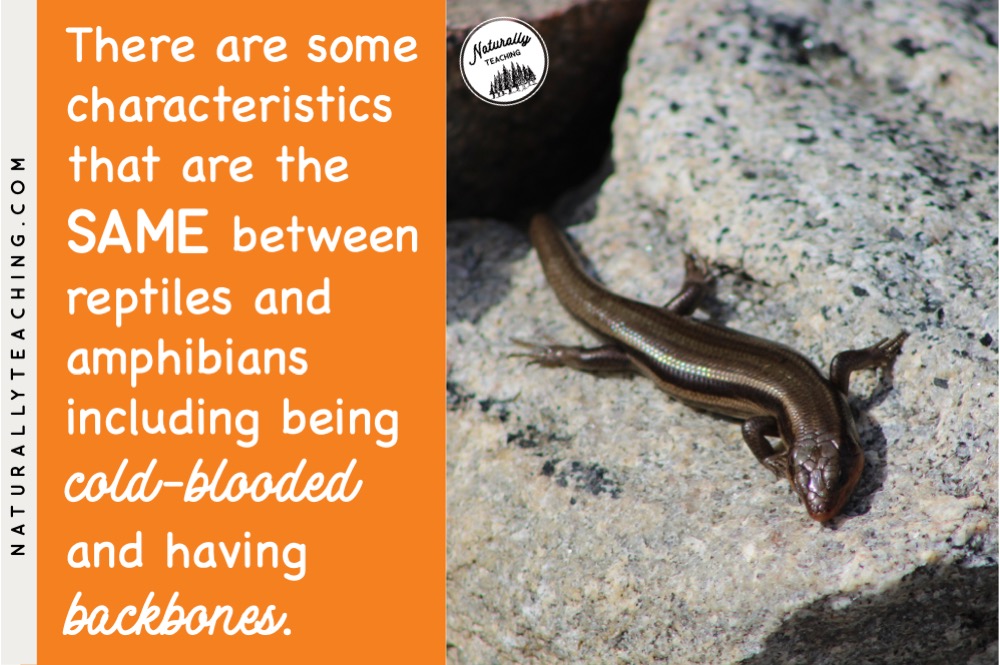
There are some characteristics that are the same between reptiles and amphibians. Both groups of animals are cold-blooded, or ectothermic. This means that they rely on external sources to regulate their body heat. If you’re explaining cold-blooded to your students, consider saying that cold-blooded animals get their heat from nature or their surroundings.
Another similarity is that both reptiles and amphibians have backbones or vertebrae. The backbone protects the spinal cord which passes signals from the brain to the rest of the body. This characteristic also helps scientists classify reptiles and amphibians into a larger group of animals called “vertebrates” along with fish, birds, and mammals.
Amphibians have their own traits that make them unique from reptiles and other animal groups. Some specialized characteristics of amphibians include having moist skin, being able to breathe through their skin, laying gelatinous eggs, and metamorphosis in their life cycle.
Amphibians require moisture for their skin whether they live on land or in the water. The moist skin covers the amphibian’s body, protects its organs, provides camouflaging color, and helps with oxygen exchange.
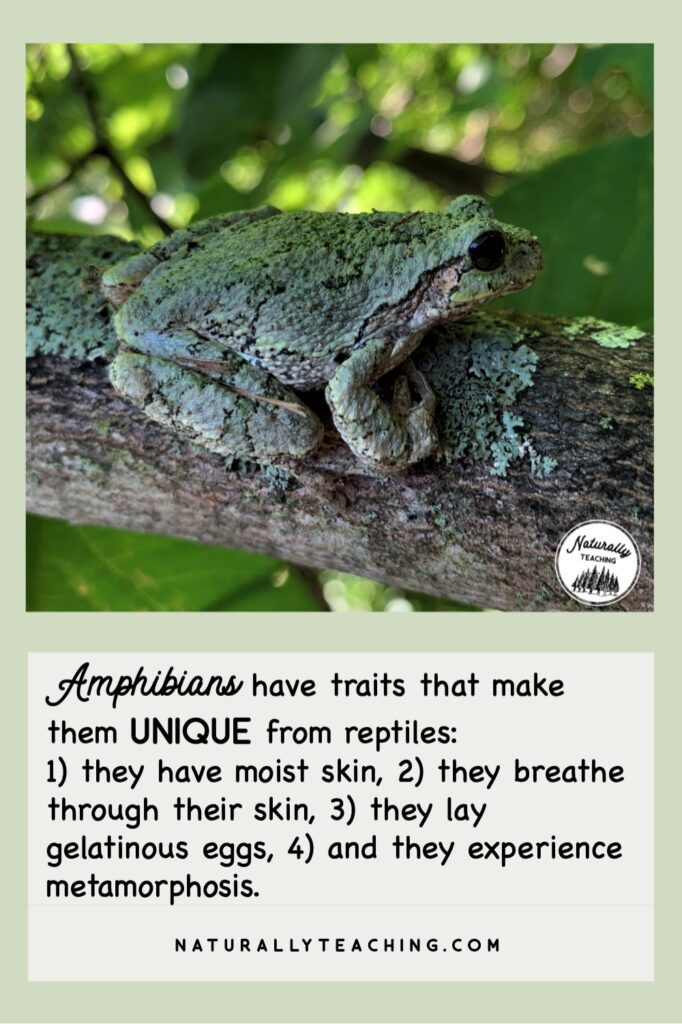
Most amphibians have lungs, but some can only breathe through their skin, like the lungless Red-backed salamander. Amphibians can breathe through their skin because it stays moist by water or by mucous they secrete. The moisture absorbs oxygen which moves through their specialized skin to the blood vessels right at the skin’s surface which then circulates to the rest of the body.
Amphibians lay gelatinous eggs in the water. Amphibian eggs do not have membranes that cover and protect the developing embryos like the eggs of birds, reptiles and mammals. Because amphibian eggs don’t have this membrane, they lay their eggs in water so that they don’t dry out.
Amphibians experience metamorphosis, stages of transformation from an immature, or young, form to an adult form. Many amphibian species begin life in the water as a tadpole (including salamanders and newts), and change over time to their adult form. Many species will leave the water and move on land for their adult lives, returning to the water to mate and lay their own eggs.
Reptiles have their own traits that make them unique from amphibians and other animal groups. A reptile characteristic that sets them apart is that they are covered in scales. Scales protect the animal’s skin and provide camouflaging colors.
Another reptile characteristic that is unique to this animal group is that reptiles, except for snakes, have claws on their feet. Reptiles use their claws for climbing and for reproduction. They can use claws to either hold onto the female while reproducing or for mating behaviors such as a male turtle tickling a female’s face.
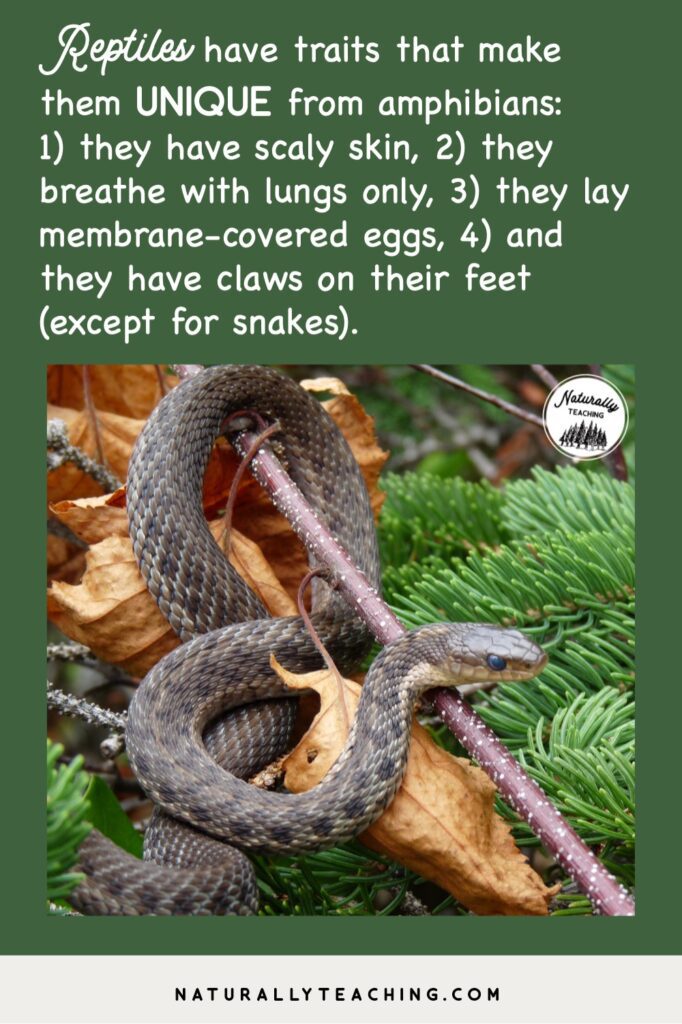
Reptiles also lay eggs, but they lay them on land. Reptiles have eggs that need to remain dry and will often bury them in sand or other sediment. By burying them, they can keep them hidden from predators and also keep them temperature-controlled. Some reptiles, such as the Eastern Garter snake, give live birth to baby snakes that they don’t take care of after birth.
Reptiles breathe air using their lungs. Reptiles don’t have the ability to breathe through their skin and have to surface if underwater in order to get a breath of air. One exception to this characteristic is that they can exchange oxygen through their cloaca when they are overwintering in sediment.
So when thinking about amphibians vs reptiles, one difference between amphibians and reptiles is their covering. Amphibians have skin that must stay moist whereas reptiles have skin that is covered in scales.
Another difference between amphibians and reptiles is their eggs. Amphibians lay gelatinous eggs in water while reptiles lay membrane-covered eggs on land.
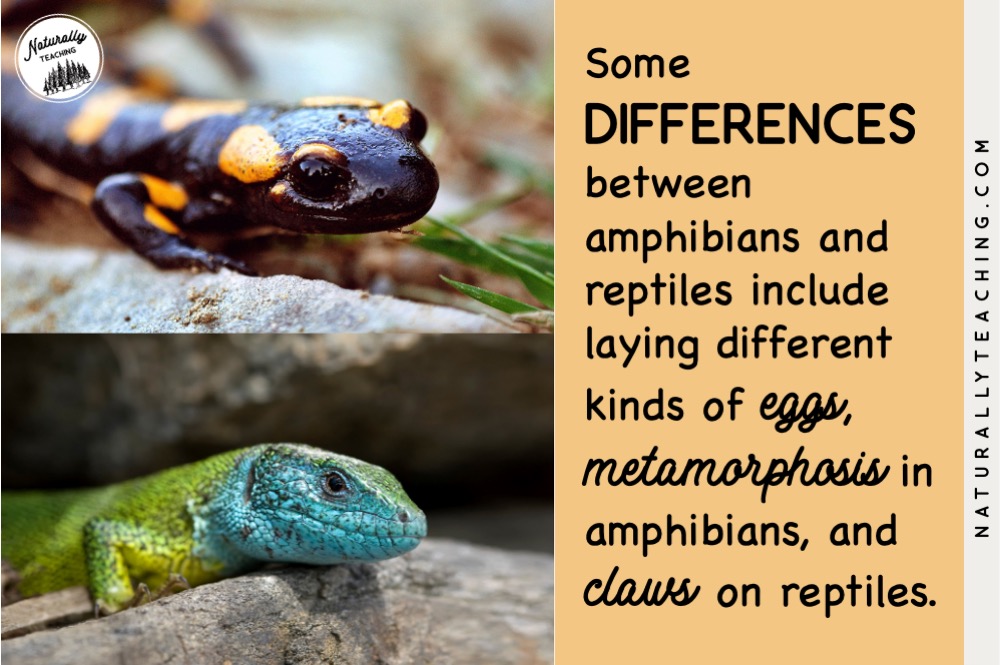
Metamorphosis is unique to amphibians. Each amphibian experiences a life cycle where their immature form looks substantially different from their adult form. Reptiles exit their eggs looking like miniature versions of the adult and grow into their adult size and coloration over time.
Claws are unique to reptiles. Reptiles use these claws for different survival activities including climbing and reproduction. Some amphibians have sticky pads on the ends of their toes, while others have webbed feet for swimming, and others have nothing at all.
When thinking about amphibians vs reptiles, it could be interesting to have a list of all of the different species that fall into each group. I have news though, there are approximately 10,700 species of reptiles and approximately 8,600 species of amphibians.
So that being said, I’m going to give you a simplified version of an amphibians and reptiles list that gives descriptions for groups of animals that would be classified as amphibians or reptiles.
There are three groups of animals that fall into the amphibian class. These include Anura, the frogs and toads, Caudata, the salamanders and newts, and Gymnophiona, the caecilians.
The phylum Anura that includes frogs and toads is easy enough to understand; most of us have seen a frog or a toad in our lives. Frogs can be found on 6 continents around the world and can live in many different habitats including ponds, rivers, lakes, trees, forest floors, and more. Toads don’t often live in aquatic ecosystems but can be found on land such as forest floors and deserts.
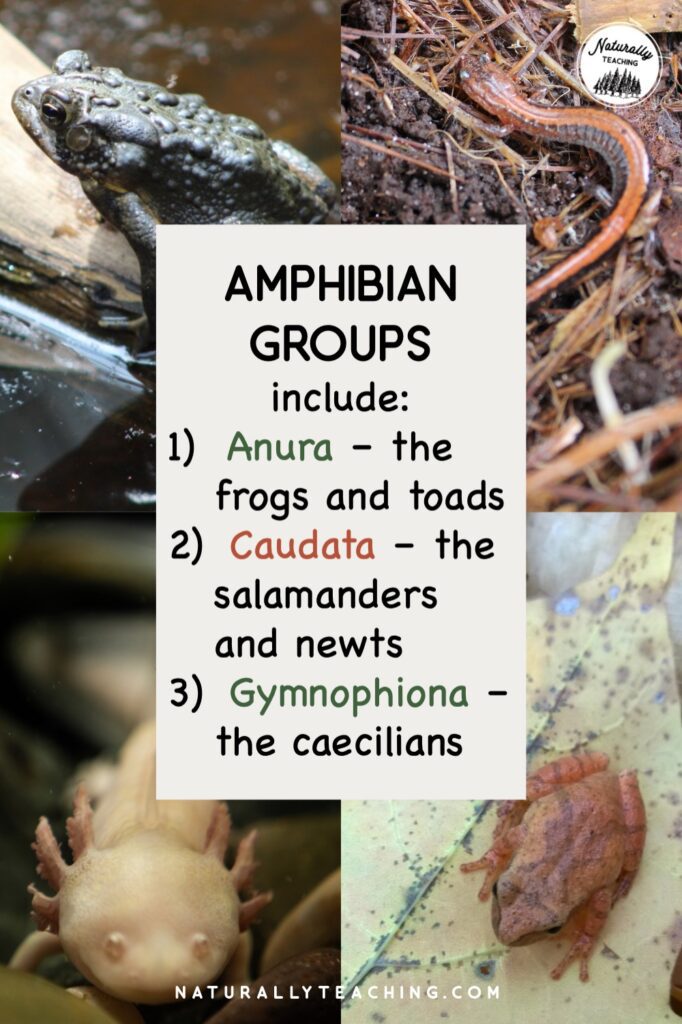
The phylum Caudata includes salamanders and newts. This group of amphibians is shy and isn’t as well known as the toad and frog group. Salamanders have a similar look to lizards and sometimes get mis-identified as a lizard. Newts are often found in aquatic ecosystems such as ponds, creeks, and lakes while salamanders are more often found on land in ecosystems such as forests and edges of ponds.
The phylum Gymnophiona that includes caecilians is not very well known. Caecilians are legless amphibians that look like moist snakes, land-eels, or earthworms. This group of amphibians is incredibly shy and spends most of their time underground. Almost all known species of caecilians live on land in forests but can also be found in some grasslands, savannas, shrub lands, and wetlands.
There are four groups of animals that fall into the reptile class. These include Crocodilia, the crocodiles and alligators, Squamata, the snakes and lizards, Testudine, the turtles and tortoises, and Sphenodontia, lizard-like creatures.
The phylum Crocodilia includes crocodiles and alligators. This group includes the largest reptiles with the most advanced brains. Most crocodiles and alligators can be found in tropical and subtropical rivers, swamps, and streams.
The phylum Squamata includes snakes and lizards. Snakes and lizards are covered in horny scales that are shed when ready. They also have abdomens that help them move from place to place, whether that’s by crawling or by slithering. Snakes live in a variety of ecosystems including grasslands, forests, deserts, and wetlands. Lizards tend to inhabit ecosystems such as deserts, forests, prairies, wetlands, and rocky areas.
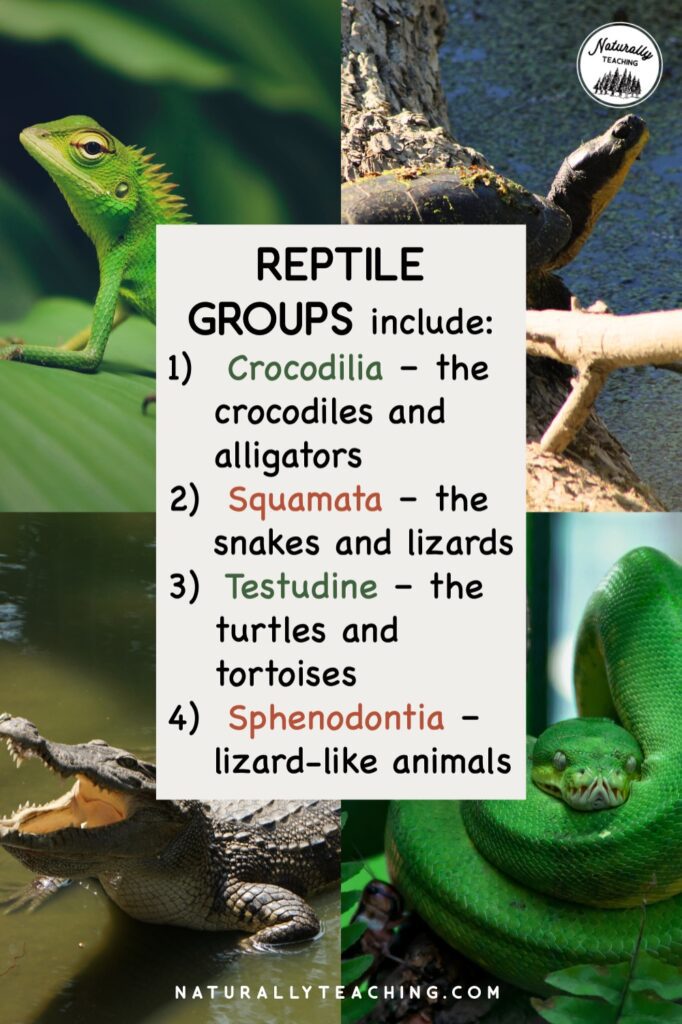
The phylum Testudine includes turtles and tortoises. The members of this reptile group are well-known for their shells which include their spine and protective scutes. Many turtle species are aquatic, living in ecosystems such as ponds, wetlands, lakes, rivers, and oceans. Some turtle species, like the Eastern Box turtle, live on land. Most tortoises are terrestrial and inhabit a variety of ecosystems such as deserts, grasslands, scrub forests, evergreen forests, and mountainsides.
The phylum Sphenodontia includes lizard-like creatures called tuatara. These creatures have a less developed brain than most other reptiles and they also have more primitive eye sockets. The last living species is called tuatara and can be found in New Zealand. Although there are few species that fall into this reptilian category today, they were quite prevalent during the Mesozoic era.
There are many different ways that you could teach the difference between amphibians vs reptiles. I’ll give you a few different ideas for activity types and then you can modify based on the needs of your students.
First, consider an active game. You could create a relay race by printing the characteristics of reptiles and amphibians on cards that your students have to sort. Print enough sets of characteristics that you can break your class up into groups of 3 or 4. Spread them out in a field or in the gym, putting a set of characteristics cards in front of each of your groups. Have one student from each group pick up a card, run out to your “reptile” and “amphibian” category cards, place their card in front of the appropriate group name, and then tag the next person’s hand from their team. This person grabs a new card, runs out to the category cards, places it in front of the appropriate group name, and so on until the cards are all gone. Wrap up the activity by reviewing the cards that are placed in each category. (*Bonus, these cards can also work for sorting at a center!)
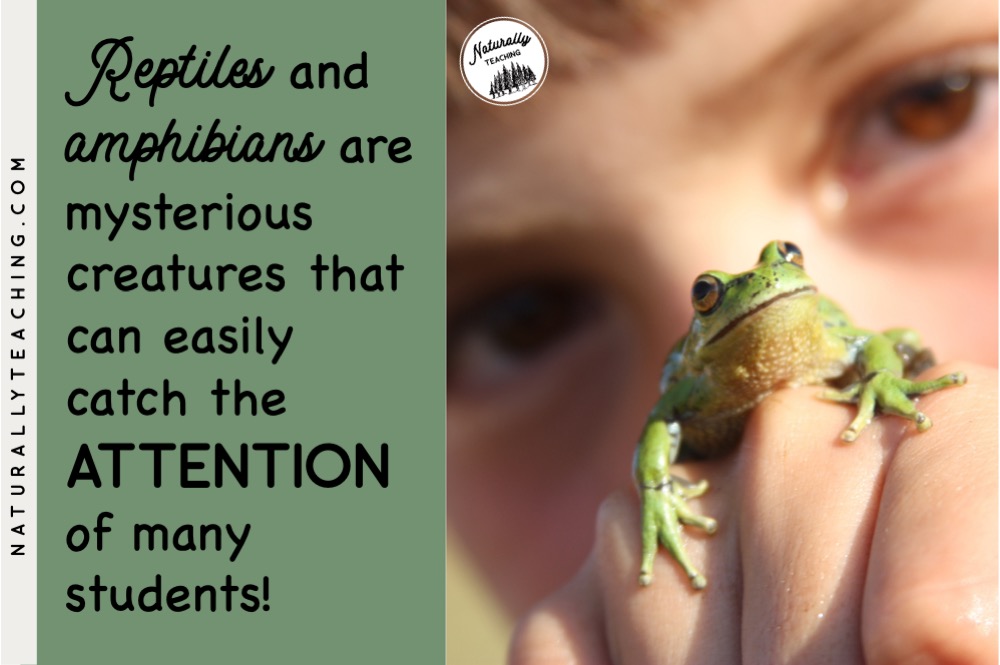
You could also consider a “Guess Who” type game where you give hints for the different characteristics of each animal group. Your students would listen to the clues and try to identify if the characteristic belongs to a reptile or an amphibian. Sometimes, the characteristic could belong to either group and that’s ok. An example of a clue for scales of reptiles could be, “this covering is hard and protects the animal. It can give camouflaging colors, and is made up of small pieces that fit together like a puzzle.”
Another option would be to provide your students with worksheets that could illustrate the differences of amphibians vs reptiles. These could take the form of booklets, sort worksheets, coloring pages, and more. These could be a good option as an introduction or as a conclusion, but having some other activity types can help create memories connected to the material that will help them remember the content easier.
Reptiles and amphibians are mysterious creatures that can easily catch the attention of many of your students. If you are lucky enough to have the chance to study these wonderful animals in your classroom, use some of the characteristics explained in this article to help your students remember who is who and what makes them special.
If you’re looking for already-created resources that could help you teach amphibians vs reptiles in your classroom, take a look at my animal characteristics resources in my Teachers Pay Teachers store. There is a reptile characteristic booklet, a characteristics of amphibians booklet, and a reptile and amphibian characteristics sort activity.
Bibliography
AmphibiaWeb. (2023). Amphibian Species by the Numbers. Retrieved from https://amphibiaweb.org/amphibian/speciesnums.html
iNaturalist.ca. (n.d.) Sphenodonts. Retrieved from https://inaturalist.ca/taxa/372879-Sphenodontia
Owuor, S. (2019, January 14). How Many Species of Reptiles Are There? Retrieved from https://www.worldatlas.com/articles/how-many-species-of-reptiles-are-there.html
University College London. (n.d.). Vertebrate Diversity. Retrieved from https://www.ucl.ac.uk/museums-static/obl4he/vertebratediversity/caecilians.html
Do you have any amazing experiences teaching amphibians vs reptiles in your classroom? Describe them in the comments section to inspire a fellow elementary teacher to take action!
Looking for more information about animals? Check out “What Butterfly Looks Like a Monarch and 4 Other Butterfly Survival Strategies”!
2 thoughts on “Amphibians Vs Reptiles: How to Teach the Difference in Your Elementary Classroom”